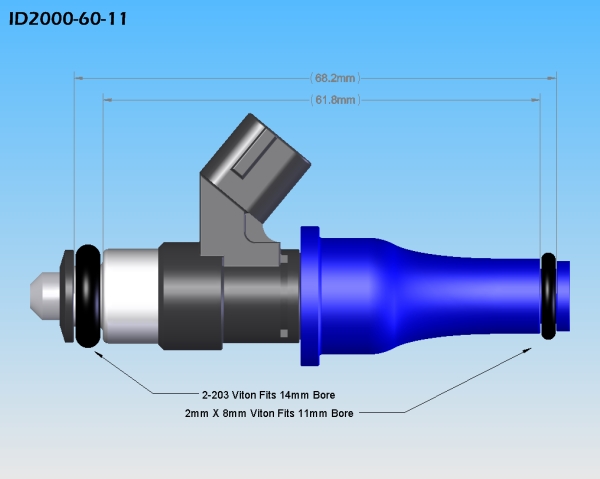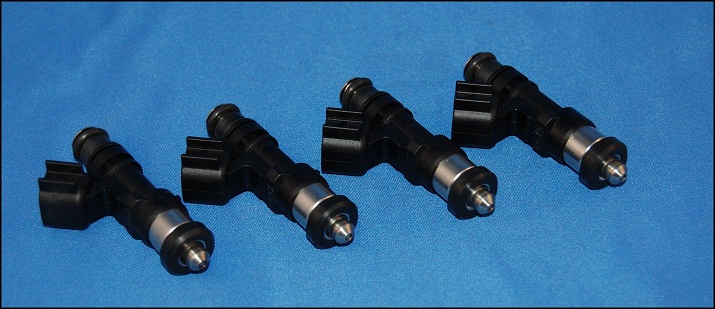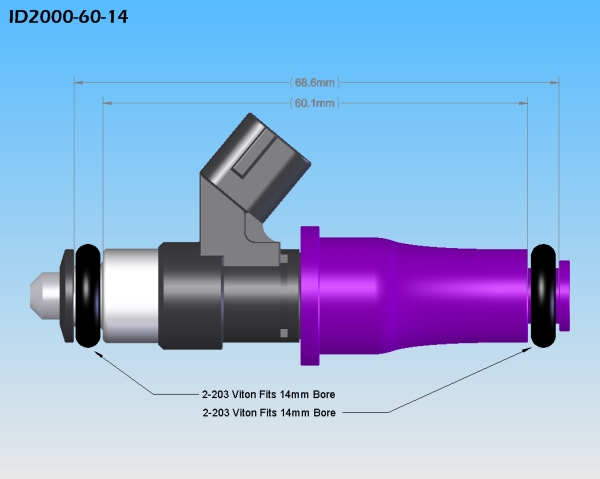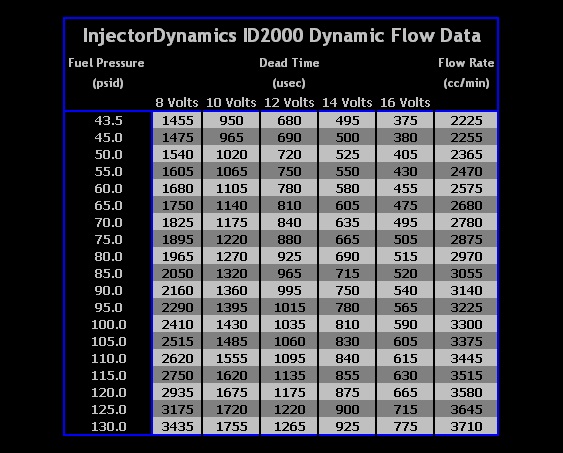Comprehensive Injector Dynamics fitment guide
#1
Comprehensive Injector Dynamics fitment guide
Quick Guide
FD with aftermarket Bosch style top feed rail (14mm o-ring bore): purple top injectors with Denso cushion on bottom, no spacers or anything else needed at the bottom to make a proper seal. This is the most common configuration for a single turbo FD.
FD with aftermarket Denso style top feed rail (11mm o-ring bore): blue top injectors with Denso cushion on bottom, no spacers or anything else needed at the bottom to make a proper seal. This style rail is not as common on FD single turbo setups.
FC with OEM rails (11mm o-ring bore): blue top injectors with Denso cushion on bottom, no spacers or anything else needed at the bottom to make a proper seal
FC with aftermarket Bosch style top feed rail (14mm o-ring bore): purple top injectors with Denso cushion on bottom, no spacers or anything else needed at the bottom to make a proper seal
Fuller explanation
Injector Dynamics sell high impedence injectors nominally rated at 725cc, 1000cc, and 2000cc while being based off the recent Bosch EV14 design. I recently exchanged a number of emails with them to figure out the simplest fitment on both FC and FD engines.
On the ID website you can order "direct fitment" parts. Here it is for the ID2000: http://www.t1racedevelopment.com/en/...-set,rx-7.html
For the FC with stock top feed rails: You want to select the 11mm top in order to drop right in to the factory rail. The 11mm injectors are blue:

When you order "direct fitment" you should receive a cushion so that the injectors will seal properly on the bottom:

The cushion is used instead of the normal 14mm o-ring you would find on the bottom of say the older Bosch 1680cc injectors. when using the Denso cushion no spacers or other special hardware are required to seal at the bottom . This cushion is also available separately under the fuel delivery-->connectors and accessories section of the site. Here is a pic they provided of how the cushions look when installed (you would not be using a black injector):

For FD and FC engines with aftermarket Bosch style rails (such as the KG rail), you want the 14mm top purple injectors:

These will also use the cushion at the bottom to seal properly. Some FD owners may have smaller 11mm bore fuel rails, and they will need to use the blue injectors.
For the injector connectors, the ID725 and ID1000 use a Bosch EV6 style connector (also labeled "USCAR")

The ID2000 uses a Denso style connector like you would see on a lot of Hondas:

FD with aftermarket Bosch style top feed rail (14mm o-ring bore): purple top injectors with Denso cushion on bottom, no spacers or anything else needed at the bottom to make a proper seal. This is the most common configuration for a single turbo FD.
FD with aftermarket Denso style top feed rail (11mm o-ring bore): blue top injectors with Denso cushion on bottom, no spacers or anything else needed at the bottom to make a proper seal. This style rail is not as common on FD single turbo setups.
FC with OEM rails (11mm o-ring bore): blue top injectors with Denso cushion on bottom, no spacers or anything else needed at the bottom to make a proper seal
FC with aftermarket Bosch style top feed rail (14mm o-ring bore): purple top injectors with Denso cushion on bottom, no spacers or anything else needed at the bottom to make a proper seal
Fuller explanation
Injector Dynamics sell high impedence injectors nominally rated at 725cc, 1000cc, and 2000cc while being based off the recent Bosch EV14 design. I recently exchanged a number of emails with them to figure out the simplest fitment on both FC and FD engines.
On the ID website you can order "direct fitment" parts. Here it is for the ID2000: http://www.t1racedevelopment.com/en/...-set,rx-7.html
For the FC with stock top feed rails: You want to select the 11mm top in order to drop right in to the factory rail. The 11mm injectors are blue:

When you order "direct fitment" you should receive a cushion so that the injectors will seal properly on the bottom:
The cushion is used instead of the normal 14mm o-ring you would find on the bottom of say the older Bosch 1680cc injectors. when using the Denso cushion no spacers or other special hardware are required to seal at the bottom . This cushion is also available separately under the fuel delivery-->connectors and accessories section of the site. Here is a pic they provided of how the cushions look when installed (you would not be using a black injector):

For FD and FC engines with aftermarket Bosch style rails (such as the KG rail), you want the 14mm top purple injectors:

These will also use the cushion at the bottom to seal properly. Some FD owners may have smaller 11mm bore fuel rails, and they will need to use the blue injectors.
For the injector connectors, the ID725 and ID1000 use a Bosch EV6 style connector (also labeled "USCAR")
The ID2000 uses a Denso style connector like you would see on a lot of Hondas:
#5
#6
The injector settings were discussed here: https://www.rx7club.com/3rd-generation-specific-1993-2002-16/fjo-injector-driver-installation-895398/page2/
The Datalogit does let you enter very high values for the secondary injectors. It is the Commander that maxes out. So far a popular approach for the ID2000 is to directly enter the injector lag vs battery voltage information into the settings 5 table. Then you can leave the normal lag "trim" adjustments (available in the Datalogit but also in the commander) to zero.
Using that method with a base pressure of 40psi the size should be 2200 and lag settings are:
16V - 0.380
14V - 0.500
12V - 0.688
10V - 0.964
8V - 1.476
For higher base pressure this chart has been supplied by Injector Dynamics:

there are a couple different approaches/settings people are using for overlap and transition. see the thread listed above for one approach used by thewird, who is using ID1000's as primaries
The Datalogit does let you enter very high values for the secondary injectors. It is the Commander that maxes out. So far a popular approach for the ID2000 is to directly enter the injector lag vs battery voltage information into the settings 5 table. Then you can leave the normal lag "trim" adjustments (available in the Datalogit but also in the commander) to zero.
Using that method with a base pressure of 40psi the size should be 2200 and lag settings are:
16V - 0.380
14V - 0.500
12V - 0.688
10V - 0.964
8V - 1.476
For higher base pressure this chart has been supplied by Injector Dynamics:

there are a couple different approaches/settings people are using for overlap and transition. see the thread listed above for one approach used by thewird, who is using ID1000's as primaries
#7
And for anyone wondering. There are zero tunability issues with the ID725's running on the primaries. And for the ID1000's, they just require a bit of negative lag (@43.5 PSi base pressure) with no affect anywhere else and might not even need any at a lower base pressure. I was very happy with the ID1000's  but unless your sure you need the extra fuel go with the ID725's for your primaries.
but unless your sure you need the extra fuel go with the ID725's for your primaries.
thewird
 but unless your sure you need the extra fuel go with the ID725's for your primaries.
but unless your sure you need the extra fuel go with the ID725's for your primaries.thewird
Trending Topics
#9
fantastic information!
I believe he said above, that you can not use the stock injector plugs. But upon a little investigating of ID's website, it seems they sell a simple plug kit that allows plug and play install.
I believe he said above, that you can not use the stock injector plugs. But upon a little investigating of ID's website, it seems they sell a simple plug kit that allows plug and play install.
#12
#13
Joined: Mar 2002
Posts: 1,526
Likes: 387
From: The Elysian Fields (Texas)
#14
ID2000 probably was just a better-sounding or memorable name than "ID2200." For example, BMW used to have their model numbering system correspond to displacement but these days that's not always true. A BMW 335 isn't a 3.5 liter engine, it's a twin turbo 3 liter.
#15
Joined: Mar 2002
Posts: 1,526
Likes: 387
From: The Elysian Fields (Texas)
Fair enough... it was the fuel pressure comment that threw me off, since I thought 43.5 base pressure was the industry standard and applicable to the ID2000's performance specs. Thanks.
#16
43.5 (3 bar) is the industry standard currently. Rx-7's run at 2.5 bar from the factory (36psi) and a lot of people run 40psi i guess because it is just a nice even number or something.
#17
FYI, we are about to release two new injectors to the lineup; the ID850 and ID1600. Both flow barely more than their names suggest..
#18
lets say your using cj motorsports fuel rail kit, with the adapters that go under the injector, would you still use the 14mm o-ring then? or would you need the denso adapter still?
#19
oh, and i noticed something else too...
in post 6, arghx has been nice enough to denote the lag times at 40psi base pressure.
but.....
this confuses me. if you look at ID's table provided, the lag at 40 and 45 are nearly the same, but 43.5 is not.
as in, the table is linear (roughly) but the lag times provided for 40psi are not linear with the rest.
could someone explain this?
in post 6, arghx has been nice enough to denote the lag times at 40psi base pressure.
but.....
this confuses me. if you look at ID's table provided, the lag at 40 and 45 are nearly the same, but 43.5 is not.
as in, the table is linear (roughly) but the lag times provided for 40psi are not linear with the rest.
could someone explain this?
#20
Yes, you will still use the 14mm o-ring on top and bottom with the CJ rails.
Hmmm, as far as the non-linearity from the table, that is strange. I remember supplying thewird those values. Let me find the correct representative numbers... I'm hoping I didn't do something as stupid as accidentally sending the 45psi values instead. The difference will be minimal, and probably unnoticeable in a running car, but I want to be 100% sure.
Hmmm, as far as the non-linearity from the table, that is strange. I remember supplying thewird those values. Let me find the correct representative numbers... I'm hoping I didn't do something as stupid as accidentally sending the 45psi values instead. The difference will be minimal, and probably unnoticeable in a running car, but I want to be 100% sure.
#21
#22
For the ID850's, the answer is fitment. They are as short as the ID2000 bodies, and many newer vehicles just don't have the room to move the fuel rails any higher than the 34mm body.
The ID1600's will be a slightly lower cost alternative to those who do not want to shell out the $240/ea for the ID2000's. I don't have the final pricing yet and for rotary guys buying 2 or maybe 4, it may not be a huge difference. However, for the v8 guys who'd spend nearly $2000 for ID2000's, the savings may add up.
While I agree that you can fuel just about anything with the current lineup, we want our customers to have options that suit their needs.
The ID1600's will be a slightly lower cost alternative to those who do not want to shell out the $240/ea for the ID2000's. I don't have the final pricing yet and for rotary guys buying 2 or maybe 4, it may not be a huge difference. However, for the v8 guys who'd spend nearly $2000 for ID2000's, the savings may add up.
While I agree that you can fuel just about anything with the current lineup, we want our customers to have options that suit their needs.
#24




 ? The 720s, 1000s and 2200s are all any one needs. 1600s and 850s are null/pointless if you ask me.
? The 720s, 1000s and 2200s are all any one needs. 1600s and 850s are null/pointless if you ask me.